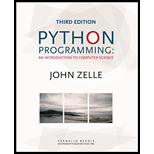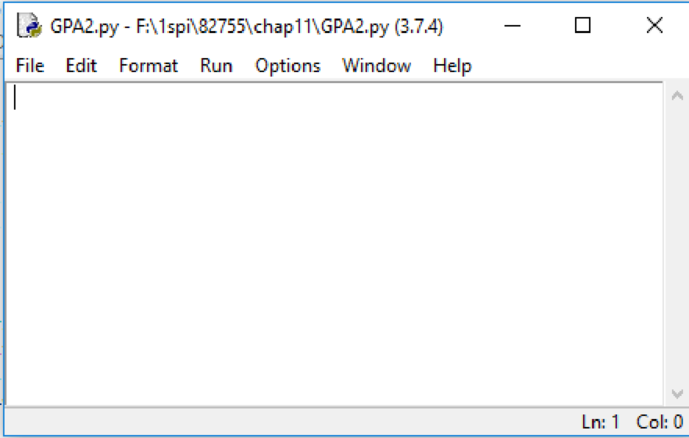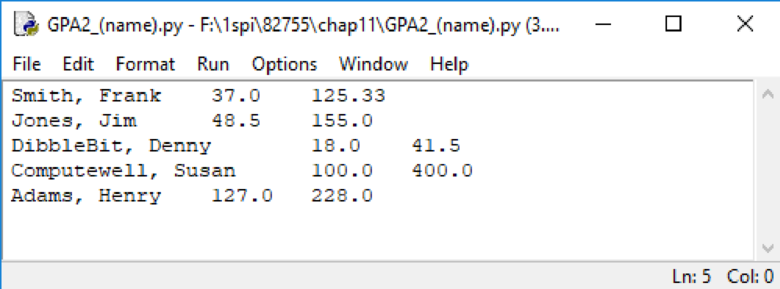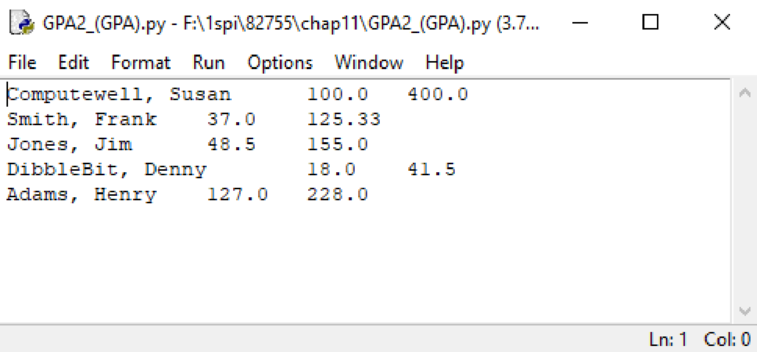
Modified gpasort program
Program plan:
- Import the necessary modules in “grade_sort.py” file.
- Define the “make_Student()” function,
- Returns student record values to the caller.
- Define the “read_Students()” function,
- Returns the list of student record to the caller.
- Define the “write_Students()” function,
- Write the student record.
- Define the “main()” function,
- Get the input file.
- Read the students record for the input file.
- Make a “while” loop for “True”.
- Get the type of input to sort.
- Get the type of ordering from the user.
- Check whether the type is “GPA” using “if”.
- If it is true, sort the data based on the “GPA”.
- Rename the file name.
- Check whether the ordering is "D"
-
- If it is true, reverse the data.
- Use “break” to exit.
- Check whether the type is “name” using “elif”.
- If it is true, sort the data based on the “name”.
- Rename the file name.
- Check whether the ordering is "D"
-
- If it is true, reverse the data.
- Use “break” to exit.
- Check whether the type is “credits” using “if”.
- If it is true, sort the data based on the “credits”.
- Rename the file name.
- Check whether the ordering is "D"
-
- If it is true, reverse the data.
- Use “break” to exit.
-
-
- Write the data into the output file.
-
- Check whether the type is “GPA” using “if”.
- Create a class Student in “gpa.py” file,
- Define the “_init_()” method.
- Assign name hours and GPoints.
-
-
-
- Define the “get_Name()” method.
- Return the name.
- Define the “get_Hours()” method.
- Return hours.
- Define the “getQ_Points()” method.
- Return GPoints.
- Define the “gpa()” method.
- Return gpa
- Define the “make_Student()” method.
- Return name, hours, and grade points.
- Define the “main()” function.
- Define the “get_Name()” method.
-
-
-
- Assign name hours and GPoints.
- Define the “_init_()” method.
- Call the “main()” function.
Explanation of Solution
Program:
File name: “gpasort.py”
#Import required module
from gpa import Student
#Define the function make_Student()
def make_Student(info_Str):
#Make multiple assignment
Name, Hours, Gpoints = info_Str.split("\t")
#Return constructor
return Student(Name, Hours, Gpoints)
#Define the function read_Students()
def read_Students(file_name):
#Open the input file for reading
in_file = open(file_name, 'r')
#Create an empty list
Students = []
#Create for loop to iterate over all lines in a file
for line in in_file:
#Append the line in a list
Students.append(make_Student(line))
#Close the input file
in_file.close()
#Return the list
return Students
#Define the function write_Students()
def write_Students(Students, file_name):
#Open output file to write
out_file = open(file_name, 'w')
#Create a for loop to iterate over list
for s in Students:
#Print output
print("{0}\t{1}\t{2}".format(s.get_Name(), s.get_Hours(), s.getQ_Points()), file = out_file)
#Close the output file
out_file.close()
#Define the main() function
def main():
#Print the string
print("This program sorts student grade information by GPA, name, or credits.")
#Get the input file
file_name = 'gpa1.txt'
#Assign the data return from read_Students()
data = read_Students(file_name)
#Create "while" loop
while True:
#Get the type
x = (input('Type "GPA", "name", or "credits" >>> '))
#Get the type of ordering
m = (input('Type "A" for ascending, "D" for descending.'))
#Check whether the type is "GPA"
if x == 'GPA':
#Sort the data based on the gpa
data.sort(key=Student.gpa)
#Rename the file name
s = "_(GPA)"
#Check whether the ordering is "D"
if m == "D":
#Reverse the data
data.reverse()
#Use break to exit
break
#Check whether the type is "name"
elif x == 'name':
#Sort the data based on the name
data.sort(key=Student.get_Name)
#Rename the file name
s = "_(name)"
#Check whether the ordering is "D"
if m == "D":
#Reverse the data
data.reverse()
#Use break to exit
break
#Check whether the type is "credits"
elif x == 'credits':
#Sort the data based on the credits
data.sort(key=Student.getQ_Points)
#Rename the file name
s = "_(credits)"
#Check whether the ordering is "D"
if m == "D":
#Reverse the data
data.reverse()
#Use break to exit
break
#Otherwise
else:
#Print the string
print("Please try again.")
#Assign the output file
filename = "GPA2" + s + ".py"
#Write the data into output file
write_Students(data, filename)
#Print output file
print("The data has been written to", filename)
#Call the main function
if __name__ == '__main__': main()
File name: “gpa.py”
#Create a class Student
class Student:
#Define _init_() method
def __init__(self, Name, Hours, Gpoints):
self.Name = Name
self.Hours = float(Hours)
self.Gpoints = float(Gpoints)
#Define get_Name() method
def get_Name(self):
#Return the name
return self.Name
#Define get_Hours()
def get_Hours(self):
#return hours
return self.Hours
#Define getQ_Points()
def getQ_Points(self):
#return grade points
return self.Gpoints
#Define the funcition gpa()
def gpa(self):
#return the value
return self.Gpoints / self.Hours
#Define the function make_Student()
def make_Student(info_Str):
#Make multiple assignment
Name, Hours, Gpoints = info_Str.split("\t")
#Return the constructor
return Student(Name, Hours, Gpoints)
#Define the main() function
def main():
#Open the input file for reading
file_name = input("Enter the name of the grade file: ")
in_file = open(file_name, 'r')
#Set best to the record for the first student in the file
best = make_Student(in_file.readline())
#Process lines of the file using "for" loop
for line in in_file:
#Make the line of file into a student record
s = make_Student(line)
#Checck whether the student is best so far
if s.gpa() > best.gpa():
#Assign the best student record
best = s
#Close the input file
in_file.close()
#Print information about the best student
print("The best student is:", best.get_Name())
print("Hours:", best.get_Hours())
print("GPA:", best.gpa())
if __name__ == '__main__':
#Call the main() function
main()
Contents of “gpa1.txt”
Adams, Henry 127 228
Computewell, Susan 100 400
DibbleBit, Denny 18 41.5
Jones, Jim 48.5 155
Smith, Frank 37 125.33
Screenshot of output file “GPA2.py” before execution:

Output:
This program sorts student grade information by GPA, name, or credits.
Type "GPA", "name", or "credits" >>> name
Type "A" for ascending, "D" for descending.D
The data has been written to GPA2_(name).py
>>>
Screenshot of output file “GPA2_(name).py after execution:

Additional output:
This program sorts student grade information by GPA, name, or credits.
Type "GPA", "name", or "credits" >>> GPA
Type "A" for ascending, "D" for descending.D
The data has been written to GPA2_(GPA).py
>>>
Screenshot of output file “GPA2_(gpa).py after execution:

Want to see more full solutions like this?
Chapter 11 Solutions
Python Programming: An Introduction to Computer Science, 3rd Ed.
- Complete the JavaScript function addPixels () to calculate the sum of pixelAmount and the given element's cssProperty value, and return the new "px" value. Ex: If helloElem's width is 150px, then calling addPixels (hello Elem, "width", 50) should return 150px + 50px = "200px". SHOW EXPECTED HTML JavaScript 1 function addPixels (element, cssProperty, pixelAmount) { 2 3 /* Your solution goes here *1 4 } 5 6 const helloElem = document.querySelector("# helloMessage"); 7 const newVal = addPixels (helloElem, "width", 50); 8 helloElem.style.setProperty("width", newVal); [arrow_forwardSolve in MATLABarrow_forwardHello please look at the attached picture. I need an detailed explanation of the architecturearrow_forward
- Information Security Risk and Vulnerability Assessment 1- Which TCP/IP protocol is used to convert the IP address to the Mac address? Explain 2-What popular switch feature allows you to create communication boundaries between systems connected to the switch3- what types of vulnerability directly related to the programmer of the software?4- Who ensures the entity implements appropriate security controls to protect an asset? Please do not use AI and add refrencearrow_forwardFind the voltage V0 across the 4K resistor using the mesh method or nodal analysis. Note: I have already simulated it and the value it should give is -1.714Varrow_forwardResolver por superposicionarrow_forward
- Describe three (3) Multiplexing techniques common for fiber optic linksarrow_forwardCould you help me to know features of the following concepts: - commercial CA - memory integrity - WMI filterarrow_forwardBriefly describe the issues involved in using ATM technology in Local Area Networksarrow_forward
- For this question you will perform two levels of quicksort on an array containing these numbers: 59 41 61 73 43 57 50 13 96 88 42 77 27 95 32 89 In the first blank, enter the array contents after the top level partition. In the second blank, enter the array contents after one more partition of the left-hand subarray resulting from the first partition. In the third blank, enter the array contents after one more partition of the right-hand subarray resulting from the first partition. Print the numbers with a single space between them. Use the algorithm we covered in class, in which the first element of the subarray is the partition value. Question 1 options: Blank # 1 Blank # 2 Blank # 3arrow_forward1. Transform the E-R diagram into a set of relations. Country_of Agent ID Agent H Holds Is_Reponsible_for Consignment Number $ Value May Contain Consignment Transports Container Destination Ф R Goes Off Container Number Size Vessel Voyage Registry Vessel ID Voyage_ID Tonnagearrow_forwardI want to solve 13.2 using matlab please helparrow_forward
 C++ Programming: From Problem Analysis to Program...Computer ScienceISBN:9781337102087Author:D. S. MalikPublisher:Cengage Learning
C++ Programming: From Problem Analysis to Program...Computer ScienceISBN:9781337102087Author:D. S. MalikPublisher:Cengage Learning EBK JAVA PROGRAMMINGComputer ScienceISBN:9781337671385Author:FARRELLPublisher:CENGAGE LEARNING - CONSIGNMENTProgramming Logic & Design ComprehensiveComputer ScienceISBN:9781337669405Author:FARRELLPublisher:Cengage
EBK JAVA PROGRAMMINGComputer ScienceISBN:9781337671385Author:FARRELLPublisher:CENGAGE LEARNING - CONSIGNMENTProgramming Logic & Design ComprehensiveComputer ScienceISBN:9781337669405Author:FARRELLPublisher:Cengage Microsoft Visual C#Computer ScienceISBN:9781337102100Author:Joyce, Farrell.Publisher:Cengage Learning,
Microsoft Visual C#Computer ScienceISBN:9781337102100Author:Joyce, Farrell.Publisher:Cengage Learning, C++ for Engineers and ScientistsComputer ScienceISBN:9781133187844Author:Bronson, Gary J.Publisher:Course Technology Ptr
C++ for Engineers and ScientistsComputer ScienceISBN:9781133187844Author:Bronson, Gary J.Publisher:Course Technology Ptr New Perspectives on HTML5, CSS3, and JavaScriptComputer ScienceISBN:9781305503922Author:Patrick M. CareyPublisher:Cengage Learning
New Perspectives on HTML5, CSS3, and JavaScriptComputer ScienceISBN:9781305503922Author:Patrick M. CareyPublisher:Cengage Learning





